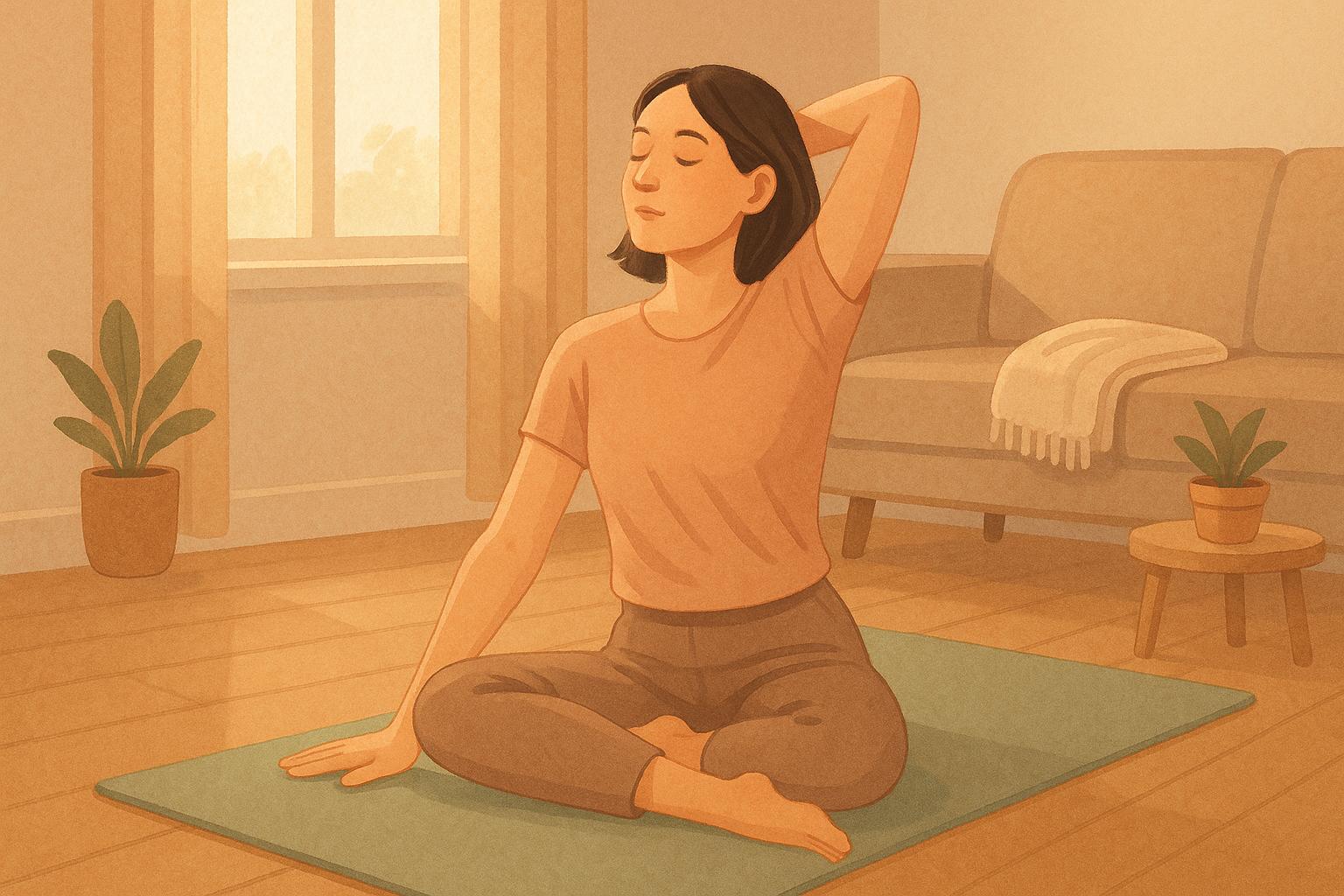Chronic back pain affects 1 in 6 New Zealanders, lasting over three months and disrupting daily life. It can hinder mobility, sleep, physical activity, and mental health. But there are effective ways to manage it without surgery. Here’s a quick overview:
Key Solutions:
- Chiropractic Care: Aligns the spine to reduce nerve pressure and improve mobility. Initial consultation at Balmoral Chiropractic costs $80 and includes a personalised treatment plan.
- At-Home Tips:
- Strengthen your back with exercises like Bird Dog and Glute Bridge.
- Maintain proper posture while sitting or lifting objects.
- Eat anti-inflammatory foods like salmon, blueberries, and spinach.
- Stay active with low-impact exercises like walking or swimming.
- Lifestyle Adjustments: Focus on relaxation techniques like deep breathing and mindfulness to reduce stress and support recovery.
Quick Comparison of Treatment Options:
| Method | Benefits | Timeline | Cost (NZD) |
|---|---|---|---|
| Chiropractic Adjustments | Eases nerve pressure, improves function | 6–12 sessions | From $35 (ACC) |
| Soft Tissue Therapy | Reduces muscle tension | 4–8 sessions | Included in care |
| Rehabilitation Exercises | Strengthens muscles, prevents pain | Ongoing practice | Free (at home) |
| Posture Correction | Minimises strain, prevents recurrence | Daily application | Free (self-managed) |
How Chiropractic Care Helps Back Pain
Chiropractic care addresses chronic back pain by focusing on spinal alignment. By correcting misalignments, it helps improve nerve function, ease discomfort, and enhance mobility. Misaligned spines can irritate nerves, tighten muscles, and lead to ongoing pain, making adjustments a key part of recovery.
Your First Visit to Balmoral Chiropractic

Your first visit to Balmoral Chiropractic is all about tailoring care to your needs. Here’s what to expect:
| Assessment Component | Purpose | Duration |
|---|---|---|
| Medical History Review | Learning about your pain patterns and past care | 15 minutes |
| Physical Examination | Checking posture, movement, and spine alignment | 20 minutes |
| Treatment Plan Discussion | Developing a customised care plan | 25 minutes |
The 60-minute consultation costs $80, with partial coverage available for ACC-approved cases. After this session, your treatment follows a structured approach to improve spinal health and function.
Step-by-Step Treatment Process
1. Soft Tissue Preparation
Massage and muscle release techniques help loosen tight areas, ease tension, and improve blood flow before adjustments.
2. Spinal Assessment
The chiropractor carefully examines your spine to pinpoint problem areas needing adjustment.
3. Precise Adjustments
"Chiropractors work to realign the spine and other joints, which can reduce nerve irritability and improve overall function." – Balmoral Chiropractic
Adjustments use controlled movements to:
- Restore joint mobility
- Relieve nerve pressure
- Ease muscle tension
- Support better spinal function
4. Post-Adjustment Care
You’ll receive guidance on maintaining proper posture and movements to keep your spine aligned between visits.
Treatment frequency depends on your condition and progress. Initially, sessions may be more frequent, tapering off as improvements are made.
Managing Back Pain at Home
Taking care of your back at home is a key part of managing chronic pain and supporting recovery. Strengthening your muscles and maintaining good posture can work hand-in-hand with professional treatments.
Back and Core Strengthening Exercises
Incorporate these exercises into your routine to improve core stability and support your spine:
| Exercise | How to Do It | Duration/Repetitions |
|---|---|---|
| Core Vacuum | Exhale while pulling your navel towards your spine. | Hold for 20–30 seconds, 3 sets |
| Bird Dog | From all fours, extend one arm and the opposite leg, keeping your spine neutral. | 6–10 reps per side, 2–3 times daily |
| Glute Bridge | Lie on your back, lift your hips, and squeeze your glutes. | 3 sets of 8–15 reps |
| Superman | Lie face down and lift your arms and legs off the ground. | Hold for 30 seconds |
Correct Posture for Daily Tasks
Using proper posture during everyday activities can help minimise strain on your spine. Here’s how to adjust your posture for common tasks:
- At a desk:
- Keep your screen at eye level and within comfortable viewing distance.
- Rest your feet flat on the floor or use a footrest.
- Choose a chair that supports the natural curve of your lower back.
- Position your keyboard so your elbows are at about a 90-degree angle.
- When lifting objects:
- Hold the object close to your body.
- Bend at your knees, not your waist.
- Keep your back straight and avoid twisting as you lift.
Lifestyle Changes for Better Back Health
Making thoughtful changes to your daily routine can help alleviate chronic back pain and maintain a healthy spine.
Foods That Help Reduce Back Pain
Eating the right foods can lower inflammation, ease joint discomfort, and promote tissue healing. Here are some excellent dietary choices:
| Food Group | Examples | Benefits for Back Health |
|---|---|---|
| Fatty Fish | Salmon, tuna, mackerel | Packed with omega‑3s to combat inflammation |
| Fruits | Strawberries, oranges, blueberries, cherries | High in vitamin C for tissue repair and anti-inflammatory effects |
| Leafy Greens | Spinach, kale | Contain magnesium to support muscle function |
| Healthy Fats | Olive oil, almonds | Provide fats that reduce inflammation and help joints |
| Spices | Turmeric with black pepper | Known for natural anti-inflammatory properties |
Pairing these foods with regular, light physical activity can further relieve spinal tension and improve overall back health.
Safe Exercise Options
Low-impact exercises are a great way to strengthen your spine without causing strain. Start with a short 1‑kilometre walk and gradually increase the distance as you feel stronger. Here are some other gentle activities to consider:
- Swimming or water walking in a heated pool (around 28°C)
- Using a stationary bike while maintaining good posture
- Practising Tai Chi or gentle yoga
- Taking 15–20 minute walks on flat terrain
According to IBISWorld research, approximately 300,000 Australians visit chiropractors weekly for stretches and exercises focused on muscle health.
Mental Health and Pain Management
Managing stress and promoting relaxation play a key role in reducing back pain.
"Preventative chiropractic care supports stress reduction, sleep quality, and immunity." – Balmoral Chiropractic
Incorporate these relaxation techniques into your routine:
- Practise deep breathing for five minutes, three times a day
- Try progressive muscle relaxation to ease tension
- Use mindfulness meditation before sleep
- Combine gentle stretches with slow, controlled breathing
These methods can help improve your mental well-being while supporting your physical health.
sbb-itb-155573e
Treatment Methods for Back Pain
Discover ways to manage back pain without surgery while supporting long-term spinal health. Chiropractic care focuses on precise adjustments and supportive therapies to tackle the underlying causes and encourage the body’s natural healing process. The chart below highlights common treatment methods and their benefits.
Back Pain Treatment Options Chart
| Treatment Method | Benefits | Timeline | Best Suited For |
|---|---|---|---|
| Spinal Adjustments | Aligns the spine, eases nerve pressure | 6–12 sessions initially | Issues like misalignment or nerve compression |
| Soft Tissue Therapy | Eases muscle tension, boosts flexibility | 4–8 sessions | Muscle strain or tightness |
| Rehabilitation Exercises | Strengthens muscles, improves posture | Ongoing practice | Recovery and prevention |
| Posture Correction | Reduces strain, prevents recurring pain | Daily application | Desk workers or those sitting for long periods |
Combining these treatments with daily self-care can lead to better, longer-lasting results. For instance, pairing spinal adjustments with rehabilitation exercises often provides more effective and sustainable outcomes.
"Chiropractic care offers a holistic approach to wellness that goes beyond addressing immediate pain; it enhances overall well-being in ways that many patients find life-changing." – Balmoral Chiropractic
Key steps to improve recovery include:
- Regular Sessions: Keep up with chiropractic visits to maintain alignment.
- Stick to Routines: Follow prescribed exercises and posture tips.
- Daily Integration: Incorporate changes into your everyday habits.
- Stay Hydrated: Drinking enough water supports healthy tissues.
Next Steps for Back Pain Relief
Ready to take control of your back pain? Here’s how you can move forward with effective care and support.
Book Your Assessment
Schedule your initial assessment for $80. This includes a thorough medical review and physical examination to uncover the root causes of your discomfort and develop a personalised treatment plan.
Regular Appointment Pricing
- Non‑ACC visits: $50
- ACC‑covered visits: $35
- Senior rates: $45
These pricing details give you a clear understanding of the costs involved.
Family Care Options
- Couples: $90 per visit
- One adult and one child: $70 per visit
- One adult and two children: $90 per visit
- Two adults and one child: $105 per visit
- Two adults with two or more children: starting at $130 per visit
Once you’ve chosen the right option for you, make sure you’re prepared for your visit.
What to Bring
- Recent medical records
- Any X‑rays or scans
- A list of current medications
- Comfortable clothing for your session
What to Expect
During your first consultation, your chiropractor will design a personalised treatment schedule tailored to your needs.
Daily Support Tips
- Stick to your prescribed exercise routine
- Practise recommended posture techniques
- Make lifestyle adjustments as suggested
- Follow your treatment plan closely
Get in touch with Balmoral Chiropractic at their Central Auckland clinic to start your journey to lasting relief. Their approach focuses on addressing the source of your pain while supporting your body’s natural healing abilities.
FAQs
How can chiropractic care help manage chronic back pain effectively?
Chiropractic care is a natural and holistic approach to managing chronic back pain. By focusing on the root causes of discomfort, chiropractors use precise spinal adjustments to improve alignment, reduce inflammation, and restore proper function. This can provide long-term relief without relying on medication or invasive treatments.
Regular chiropractic care can also enhance mobility, making everyday tasks easier and reducing the risk of future injuries. Additionally, it supports overall spinal health, helping you maintain better posture and improved quality of life over time.
What at-home exercises and lifestyle changes can support my chiropractic care for back pain?
To support your chiropractic care and manage back pain, you can integrate simple at-home exercises and lifestyle adjustments into your routine. Gentle stretches, such as cat-cow or child’s pose, can help improve flexibility and reduce tension in your back. Strengthening exercises like planks or bridges can also stabilise your spine and core.
In addition to exercises, focus on maintaining good posture throughout the day, whether you’re sitting, standing, or lifting. Make small lifestyle changes, such as using an ergonomic chair or adjusting your workstation, to reduce strain on your back. Staying active with low-impact activities like walking or swimming can further promote spinal health and alleviate discomfort.
Remember, consistency is key. These small changes, combined with regular chiropractic care, can make a significant difference in managing chronic back pain effectively.
What can I expect during my first visit to Balmoral Chiropractic, and how should I prepare?
During your first visit to Balmoral Chiropractic, you’ll begin by completing a health history form and discussing your concerns with the chiropractor. This helps us understand your condition and tailor care specifically to your needs. You’ll then undergo an examination, which may include posture analysis, movement assessments, and other tests to evaluate your spinal health.
If necessary, the chiropractor may recommend X-rays to gain deeper insights. In many cases, treatment can begin during this initial visit. The goal is to thoroughly assess your situation and develop a personalised plan to help you feel better and improve your quality of life.
To prepare, wear comfortable clothing that allows for easy movement, and bring along any relevant medical records or information about your symptoms. Arriving a few minutes early can also help ensure a smooth and relaxed start to your appointment.
